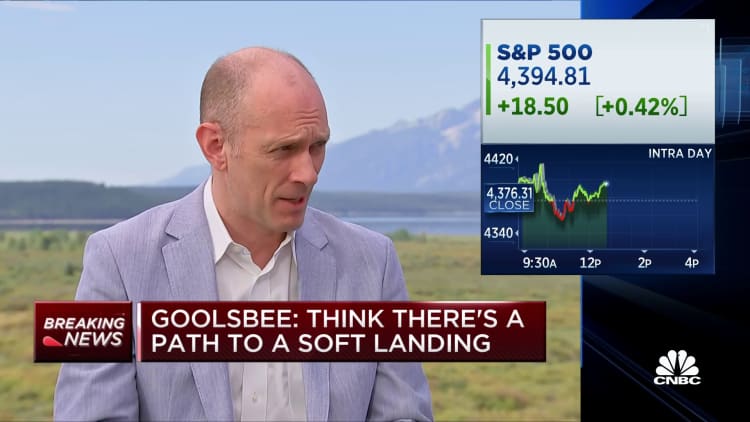Powell says ‘economy may not be cooling as expected.’ That’s good news and bad news
Federal Reserve Chair Jerome Powell said in his annual address in Jackson Hole, Wyoming early Friday that central bank policymakers “are attentive to signs that the economy may not be cooling as expected.”
On the one hand, faster-than-expected economic growth is good for corporate earnings, and means that Treasury yields have risen this summer for what investors would regard as good reasons.
On the other, yields have surged, pressuring not only growth stocks whose future earnings are discounted at the risk-free Treasury rate, but indebted companies that have to roll over their obligations at higher rates.
“So far this year, GDP (gross domestic product) growth has come in above expectations and above its longer-run trend, and recent readings on consumer spending have been especially robust,” Powell said in his speech. “In addition, after decelerating sharply over the past 18 months, the housing sector is showing signs of picking back up. Additional evidence of persistently above-trend growth could put further progress on inflation at risk and could warrant further tightening of monetary policy.”
— Scott Schnipper
Fed’s Austan Goolsbee backs sticking to 2% inflation target

Chicago Federal Reserve President Austan Goolsbee said Friday the central bank should stick to its goal to bring inflation down to 2%.
The question of whether the Fed needs to come all the way to its target, because of the risks of further tightening, has come up periodically. Earlier Friday, Chair Jerome Powell reaffirmed the commitment to 2%, and Goolsbee backed that up in an interview with CNBC’s Steve Liesman at the Fed’s Jackson Hole, Wyoming, symposium.
“I’m uncomfortable with declaring victory when it’s clearly not victory,” Goolsbee said. “We stated before we got into this what the target was going to be. I just don’t feel like you can change your inflation target until you hit it that.”
Generally considered a more dovish member of the Federal Open Market Committee, Goolsbee did not commit to a policy position. But he said that if positive inflation data continues, “Our argument is going to revolve around, well, how long should we keep rates at the levels they are, rather than how much higher should the rates go?”
—Jeff Cox
Fed’s Mester sees need for more rate hikes
Cleveland Federal Reserve President Loretta Mester said Friday she still thinks additional interest rate hikes will be needed to control inflation.
“We don’t want to be satisfied, because inflation remains too high, and we need to see more evidence to be assured that it’s coming down in a sustainable way and in a timely way,” Mester told CNBC’s Steve Liesman during an interview at the Fed’s Jackson Hole symposium.
A nonvoting member of the rate-setting Federal Open Market Committee, Mester has been one of the more hawkish Fed officials, meaning she prefers tighter policy and higher rates, at least as long as inflation holds above the central bank’s 2% target. In June, she penciled in two rate hikes this, one of which already has happened.
“We probably have some more work to do. I don’t see that much that has changed in terms of my own outlook,” she said. “What I think is very important is that we be diligent. Now, we have to be very careful. We don’t want to over-tighten, we don’t want to undershoot, and so it’s that balancing.”
—Jeff Cox
The 2- and 10-year Treasury spread hits deepest inversion since early August
A closely watched section of the U.S. Treasury yield curve on Friday notched its widest spread since early August.
The spread between the 2-year and 10-year Treasury yield hit a low of -83.50. That’s the deepest inversion since Aug. 10 when the gap widened to -88.20.
The 2-year yield neared highs of the session of 5.095%, which was the highest level since July 6 when the 2-yr yielded as high as 5.12%.
Meanwhile, the 10-year yield neared session highs at 4.285%, or the highest level since Aug. 23 when the 10-yr yielded as high as 4.32%.
— Gina Francolla, Sarah Min

